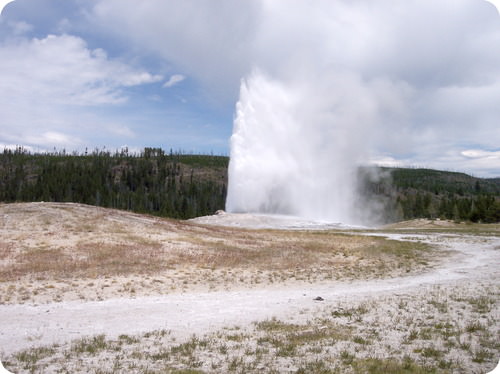17.13 蒸气化和凝聚热
章节大纲
-
How much energy is available?
::有多少能源可用?Natural resources for power generation have traditionally been waterfalls or use of oil, coal, or to generate electricity. is being carried out to look for other renewable sources to run the generators. Geothermal sites (such as the geyser pictured above) are being considered because of the steam they produce. Capabilities can be estimated by knowing how much steam is released in a given time at a particular site.
::发电的自然资源历来是瀑布或使用石油、煤炭或发电。 正在寻找其他可再生资源来管理发电机。 地热地点(如上面所描绘的喷泉)正因其产生的蒸汽而得到考虑。Heat of Vaporization and Condensation
::蒸气化和凝聚热Energy is absorbed in the process of converting a at its boiling point into a . As with the of a solid, the temperature of a boiling liquid remains constant and the input of energy goes into changing the state. The molar heat of vaporization ( Δ H vap ) of a substance is the absorbed by one mole of that substance as it is converted from a liquid to a gas. As a gas condenses to a liquid, heat is released. The molar heat of condensation ( Δ H cond ) of a substance is the heat released by one mole of that substance as it is converted from a gas to a liquid. Since vaporization and of a given substance are the exact opposite processes, the numerical value of the molar heat of vaporization is the same as the numerical value of the molar heat of condensation, but opposite in sign. In other words, Δ H vap = − Δ H cond .
::将一个物质的沸点转换成一个物质的过程中吸收了能量。与固体一样,沸点液体的温度保持不变,而能量的输入会改变状态。物质蒸发的摩尔热(Hvap)是该物质的摩尔热(Hvap),即该物质的摩尔热(Hvap),即该物质从液体转化成气体的摩尔热(Hcond),即该物质的摩尔热(Hcond),即该物质的摩尔热(Hcond),即该物质从气体转换成液体时释放的热。由于蒸发化和某种特定物质的蒸发是完全相反的过程,蒸发的摩尔热的数值与凝聚的摩尔热的数值相同,但正好相反。换句话说,“HvapHcond”。When 1 mol of water at 100°C and 1 atm pressure is converted to 1 mol of water vapor at 100°C, 40.7 kJ of heat are absorbed from the surroundings . When 1 mol of water vapor at 100°C condenses to liquid water at 100°C, 40.7 kJ of heat are released into the surroundings.
::当100°C和100°C时将1兆瓦的水压转化为1兆瓦的水蒸气时,周围吸收40.7千焦耳的热量,100°C时将1兆瓦的水蒸气凝结为100°C时的液态水,40.7千焦耳的热量释放到周围。H 2 O ( l ) → H 2 O ( g ) Δ H vap = 40.7 kJ/mol H 2 O ( g ) → H 2 O ( l ) Δ H cond = − 40.7 kJ/mol
::H2O(l)H2O(g)Hvap=40.7 kJ/molH2O(g)H2O(l)Hcond40.7 kJ/molOther substances have different values for their molar heats of fusion and vaporization and these are summarized in Table .
::其他物质在聚变和蒸发的摩尔热方面有不同的价值,这些价值汇总于表12。Molar Heats of Fusion and Vaporization Substance Δ H fus (kJ/mol) Δ H vap (kJ/mol) Ammonia (NH 3 ) 5.65 23.4 Ethanol (C 2 H 5 OH) 4.60 43.5 Methanol (CH 3 OH) 3.16 35.3 Oxygen (O 2 ) 0.44 6.82 Water (H 2 O) 6.01 40.7 Notice that for all substances, the heat of vaporization is substantially higher than the heat of fusion. Much more energy is required to change the state from a liquid to a gas than from a solid to a liquid. This is because of the large separation of the particles in the gas state. The values of the heats of fusion and vaporization are related to the strength of the intermolecular forces . All of the substances in Table , with the exception of oxygen, are capable of . Consequently, the heats of fusion and vaporization of oxygen are far lower than the others.
::注意对于所有物质来说,蒸发热大大高于聚变热,需要的能量要大得多,才能从液体变成气体,而不是从固体变成液体。这是因为气体状态中颗粒的分离很大。聚变和蒸发热的值与中间分子力量的强度有关。表内的所有物质,除氧气外,都能够。因此,聚变和氧蒸发的热远远低于其他物质。Sample Problem: Heat of Vaporization
::问题:蒸气化热What mass of methanol vapor condenses to a liquid as 20.0 kJ of heat are released?
::释放出20.0千焦热时,什么质量的甲醇蒸气浓缩成液体?Step 1: List the known quantities and plan the problem .
::第1步:列出已知数量并规划问题。Known
::已知已知-
Δ
H
=
20.0
kJ
::*H=20.0千焦耳 -
Δ
H
cond
=
−
35.3
kJ/mol
::* Hcond35.3 kJ/mol -
molar mass CH
3
OH
=
32.05
kJ/mol
::CH3OH=32.05千焦/摩尔
Unknown
::未知-
mass methanol = ? g
::甲醇质量=? g
First the kJ of heat released in the condensation is multiplied by the conversion factor of ( 1 mol − 35.3 kJ ) to find the moles of methanol that condensed. Then, moles are converted to grams.
::首先,冷凝中释放的热量KJ乘以转换系数(1 mol-35.3 kJ),以找到凝结的甲醇的摩尔。然后,摩尔转换成克。Step 2: Solve .
::步骤2:解决。− 20.0 kJ × 1 mol CH 3 OH − 35.3 kJ × 32.05 g CH 3 OH 1 mol CH 3 OH = 18.2 g CH 3 OH
::-0.0 kJx1 mol CH3OH-35.3 kJx32.05 g CH3OH1 mol CH3OH=18.2 g CH3OHStep 3: Think about your result.
::步骤3:想想你的结果。Condensation is an exothermic process, so the change is negative. Slightly more than one-half mole of methanol is condensed.
::冷凝是一种异温过程,因此变化是负的。 甲醇略多于一半的摩尔。Summary
::摘要-
Molar heats of condensation and vaporization are defined.
::界定了冷凝和蒸发的摩尔热。 -
Examples of calculations involving these parameters are illustrated.
::说明涉及这些参数的计算实例。
Review
::回顾-
What is common to all the substance in the table except oxygen?
::除了氧气以外,表中所有物质有哪些共同点? -
How much heat is needed to convert 2.7 moles of ethanol at its boiling point from liquid to vapor?
::在乙醇的沸点将2.7个乙醇摩尔从液体转化为蒸气需要多少热量? -
How many moles of water will condense from vapor to liquid if 45 kJ are removed?
::如果去除45千焦耳,从蒸气中凝结到液体中有多少摩尔水会凝结成液体?
-
Δ
H
=
20.0
kJ
